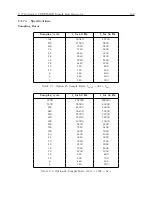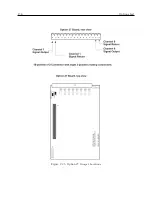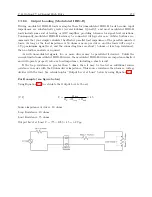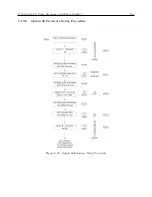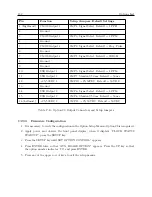
180
Options List
C.19
Option 28: Time, Frequency and Phase Monitor
C.19.1
General Description
This document describes Option 28 Power System Time, Frequency, and Phase Monitor, which is
used in the Arbiter Systems line of standard Satellite-Controlled Clocks.
C.19.2
Discussion
Option 28 provides the clock with the ability to accept either a 50Hz or 60Hz, 30-300 Vrms input
signal and measure the instantaneous phase, magnitude and frequency of the fundamental compo-
nent while rejecting the effects of harmonics, noise and DC offsets. This option also integrates total
time deviation, which is system time minus GPS time. Measurement results may be output via
the rear-panel RS-232 connector or displayed on the front panel. To determine phase shift across
a transmission line, the measured phase angles from two units placed at the ends of the line are
subtracted and normalized into the range of 0
−
360 (or
±
180) degrees. By subtracting the two
measurements of absolute phase, which are measured using the same (GPS time) reference, the
reference cancels leaving the phase angle between the two units:
A
−
B
= (
A
−
R
)
−
(
B
−
R
).
C.19.3
System Reference Connection
To connect the Option 28 board to the system reference input perform the following steps:
1. Connect System Reference (50 or 60 Hz signal) input to the Option 28 assembly, using the
6m (20 ft.) length of twinaxial cable provided. Strip the unterminated end of this cable and
prepare it as required for termination to your System Reference signal. Do not connect the
shield of the cable at the reference input end.
2. Attach this cable to the Option 28 System Reference input. Hold the cable connector by its
body (not by the rotating locking ring) and rotate it inside the twin-BNC connector until
you feel it begin to mate with the twin-BNC input of the Option 28 assembly. Once the
connectors begin to mate, then use the locking ring to secure the connectors together.
NOTE:
The supplied cable is terminated at one end with a twin-BNC connector which mates with
the system reference input of the Option 28 board.
CAUTION:
The twin-BNC connector, unlike a standard BNC connector, will only mate properly
in one orientation, and any attempt to force the connector into position with the locking ring when
it is improperly oriented (as may be done with standard BNC connectors) will not work, and may
damage the connector.
C.19.4
Firmware Configuration
To set up Option 28 from the front-panel keys, please follow the guidelines in Section 6.12, on
page 55. For Slot B option, select 28 and press the ENTER key.
You will be given additional setup choices for Option 28; Set System Time Dev?, Set UTC/Local
Time, Set 50/60 Hz Input, and Return to Main Menu. Select the desired choices. When complete
(if this is the first time these options have been activated), turn the clock OFF and back ON again
to initialize the Option Boards.
Содержание 1088A
Страница 4: ...iv ...
Страница 6: ...vi ...
Страница 18: ...xviii LIST OF FIGURES ...
Страница 23: ...1 4 Attaching Rack Mount Ears to 1088A B Series Clocks 3 Figure 1 2 Attaching Rack Mount Ears ...
Страница 24: ...4 Unpacking the Clock ...
Страница 32: ...12 Front and Rear Panels ...
Страница 38: ...18 Connecting Inlet Power Input and Output Signals ...
Страница 41: ...4 1 GPS Antenna Installation 21 Figure 4 2 Antenna Mounting Bracket Figure 4 3 Antenna Mounting with AS0044600 ...
Страница 46: ...26 GPS Antenna and Cable Information ...
Страница 48: ...28 Setting Internal Jumpers Figure 5 1 Model 1088B Main Board ...
Страница 76: ...56 The Setup Menus ...
Страница 112: ...92 Serial Communication and Command Set ...
Страница 127: ...B 4 Physical Dimensions 107 Figure B 1 Suggested Mounting of the AS0094500 Surge Arrester ...
Страница 128: ...108 Using Surge Arresters ...
Страница 137: ...C 5 Option 04 Parallel BCD Output 117 C 5 2 Option 04 Firmware Setup Figure C 2 Option 04 Firmware Setup ...
Страница 145: ...C 5 Option 04 Parallel BCD Output 125 Figure C 4 Option 04 Output Jumper Settings ...
Страница 146: ...126 Options List Figure C 5 Option 04 Board Layout and Jumper Locations ...
Страница 165: ...C 12 Option 17 Parallel BCD Output and Second RS 232 Port 145 Figure C 11 Option 17 Output Jumper Settings ...
Страница 166: ...146 Options List Figure C 12 Option 17 Board Layout and Jumper Locations ...
Страница 176: ...156 Options List C 14 5 Typical Network Configuration Figure C 15 Option 18 Network Configuration ...
Страница 187: ...C 16 Option 20A Four Fiber Optic Outputs 167 Figure C 22 Option 20A Jumper Locations ...
Страница 194: ...174 Options List Figure C 24 Option 23 Internal Jumper Setup ...
Страница 196: ...176 Options List Figure C 25 Option 27 Jumper Locations ...
Страница 214: ...194 Options List Figure C 28 Option 29 Connector Signal Locations ...
Страница 270: ...250 Options List ...




